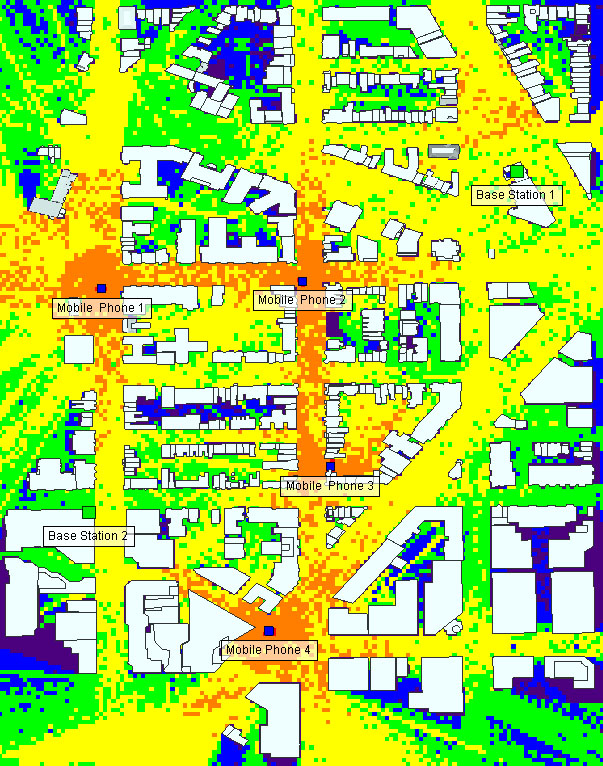Modeling an Ad Hoc Network with Transceivers in an Urban Setting
Ad hoc peer-to-peer networks can provide reliable communications in emergency situations where fixed infrastructures, like base stations, may not be available. A mobile ad hoc network (MANET) is a self-configuring network of mobile devices connected without infrastructures or wires. These networks operate independently and can be comprised of one or many transceivers. Remcom’s introduction of transceivers provides a quick way to set up and model ad hoc networks where nodes can act as both a transmitter and receiver.
Consider an urban area that is serviced by two conventional roof-mounted base stations operating at 2.154 GHz. There are four street-level mobile phone users currently communicating with base station 2 when an emergency occurs, causing base station 2 to go out of service. Further, the severity of the emergency requires residents to evacuate the area around base station 2 (Figure 1).

Figure 1: Schematic of ad hoc network scenario.
An ad hoc network using peer-to-peer communication between mobile phones can overcome the loss of base station 2, alert other mobile phone users of the situation, and advise them to leave the area.
To simulate such a scenario, Remcom created a Wireless InSite project using urban geometry and flat terrain to represent a portion of Dupont Circle in Washington, DC, covering an area of approximately 700 by 1050 meters. Two transmitters, each with a vertical half-wave dipole antenna, broadcasting at 2.154 GHz, were created to represent the roof-mounted base stations. The street level mobile phones were represented by four transceivers. Remcom’s GPU-accelerated 3D ray model, X3D, was configured to include paths with up to five reflections and one diffraction.
Figure 2 shows the received power coverage when both base stations are active.

Figure 2: Received power from base stations 1 and 2.
Table 1 shows the received power from each of the two active base stations to the four mobile phones. Assuming a mobile phone signal limit of -90 dBm, mobile phones 2 and 4 are able to establish a connection to base station 1 or base station 2, whereas mobile phones 1 and 3 can only establish a connection with base station 2.

Table 1: Received power at mobile phone locations from the two base stations.
When station 2 goes out of service, the coverage is limited as seen in: "Error! Reference source not found." The signal strength from base station 1 is too low to establish a connection to mobile phones 1 and 3; however, mobile phones 2 and 4 have sufficient signal strength to communicate with base station 1 and can rebroadcast the emergency information in their immediate vicinities as shown in Figure 3.

Figure 3: Power from base station 1 after base station 2 goes out of service.
Through peer-to-peer communication, mobile phone 2 can transmit a message that can be received by these phones, communicating to mobile phone 1 with a signal level of -54.671 dBm, and to mobile phone 3 with a signal level of -53.369 dBm (Table 2).

Table 2: Received power (dBm) in the mobile phone ad hoc network.
As mobile phones 1 and 3 receive the signal, they also rebroadcast it to the surrounding area. With all four mobile phones forming an ad hoc network and transmitting the signal, the contribution of the mobile phone transmitters more than makes up for the lost coverage from base station 2 (Figure 4).

Figure 4: Coverage from base station 1 and the four street level mobile phones.
The use of transceivers makes it simple to co-locate transmitting and receiving antennas in a single placement. In this example, Remcom used transceivers for the mobile phones and streamlined the process of setting up the mobile phones and base stations to simulate a mobile ad hoc network.
Request Project Files
Thank you for your interest in this application example. Please complete the form below to download the Modeling an Ad Hoc Network with Transceivers in an Urban Setting project files.


